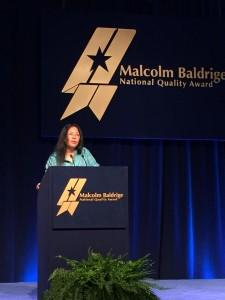Blogrige
The Official Baldrige Blog

Photo used with permission.
Southcentral Foundation (SCF) has garnered national attention as a high-performing health care organization whose relationship-based approach to care may provide a means for U.S. hospitals and systems to improve patient outcomes and reduce costs. As president and CEO, Katherine Gottlieb led SCF—whose Alaska Native community members are both owners and customers—to embrace the Baldrige Excellence Framework to guide its continuous-improvement efforts. The organization received a Baldrige Award in 2011, and Gottlieb received the Baldrige Foundation’s Harry S. Hertz Leadership Award in 2015.

At the Baldrige Program’s annual Quest for Excellence® Conference in early April, Gottlieb plans to share more about her organization’s successful practices for engaging customers using the Baldrige Excellence Framework (which includes the Health Care Criteria for Performance Excellence).
Following are her responses to some questions about her organization’s approaches and results in relation to her upcoming presentation.
1. Why is customer engagement important to your organization’s success?
Alaska Native people chose self-determination and, as a result, we own our health system. We changed everything. We call our patients “customer-owners,” and this reflects our approach to health care. We’re customers because we’ve built our health system around the 65,000 customer-owners we serve, putting what they want and need first. We’re owners because as Alaska Native people, we own our health system.
We also own and take responsibility for our physical, mental, emotional, and spiritual wellness. We asked and continue to ask our customer-owners what they want and how we can improve. Southcentral Foundation (SCF) has learned that for most health care, the customer-owner has the most control over health outcomes. Providers can prescribe medicines, treatments, and regimens, but it is the customer-owner who decides whether to follow through on the provider’s plans and treatments and also how they will follow through.
Providers are certainly important, but each customer-owner determines how they will take care of themselves and the steps they will take to achieve overall wellness. SCF saw a significant decrease in hospitalizations and emergency visits from our customer-owners after we reformed our system to focus on partnering with customer-owners and working with them on their journey toward wellness, rather than just treating problems as they arose.
We continue to tailor and develop our system, and all change at SCF is driven by customer-owners through different engagement methods. We constantly solicit input and gather feedback from customer-owners to determine the changes and improvements we should make. Once customer-owners give direction for what to do, we implement changes on an organizational level to ensure that changes diffuse across SCF. By engaging customer-owners and ensuring that change is made in accordance with what they want, we ensure that customer-owners remain satisfied, and that SCF is effective at providing the care and services customer-owners need.
2. Would you please share an example of your organization’s successful customer engagement practices?
We are present and accessible to customer-owners. Just walk in to one of our clinics, and you’ll see opportunities to provide feedback. Customer-owners can even email me directly, and I make sure our leadership hears their feedback and takes action. And we show customer-owners that we responded.
One of the examples of customer-owner engagement at SCF is our relationship-based care practice. Since customer-owners have more control over their own health outcomes than providers do, we implemented a system in which customer-owners form strong, long-term relationships with their providers. This relationship-based care system accomplishes two things. First, it helps the provider better understand the customer-owner and gain insight into the health issues they may be facing. And second, it builds trust between the customer-owner and the provider, which is critical to providers helping customer-owners make healthier choices in their lives.
There are many more examples of how the system is designed around the voice of the customer-owner. Our practice of relationship-based care has proven successful for our customer-owners.
SCF recently undertook a major research project to investigate the effect of relationships between providers and customer-owners, collecting data from a sample of over 2,000 people. Through the research, SCF found that 93.5 percent of those in the sample agreed that a relationship is important to improve health outcomes. In addition, 76.8 percent of customer-owners reported having a relationship with their primary care provider, and this figure was substantiated through analysis of the CARE Measures (developed by Glasgow and Edinburgh Universities). And customer-owners who self-reported having a relationship with their primary care provider showed better health outcomes, such as higher self-reported health ratings and fewer emergency room visits.
3. What are a few practices you’d suggest for using the Baldrige Excellence Framework to support customer engagement?
- Incorporate the Baldrige framework into employee training and help employees understand the Baldrige tools. SCF does this as early as possible, as part of new-hire orientation. When employees understand the framework and tools we use, it gives us a shared language and makes it easier to share ideas for improvement. For example, SCF uses the LeTCI evaluation tool [Baldrige results evaluation factors: Levels, Trends, Comparisons, and Integration] that allows us to take data and make sense of it at a basic level; we ensure that employees understand this tool to facilitate data-driven discussions.
- Use the Baldrige [Criteria for Performance Excellence] questions to guide discussions about improvement. If SCF is particularly strong on a question, it allows us to identify what is working well and see if elements of that process can be incorporated elsewhere in the organization. If SCF is weak on a question, it allows us to identify opportunities for improvement and can also help guide the improvement process. At SCF, the Baldrige questions are part of our strategic planning process.
- Give managers and leaders in the organization in-depth training on the Baldrige framework. At SCF, managers attend an in-house Baldrige training that is based on the Baldrige examiner training. Also, within our management foundations program, there is a course on Baldrige. Ground-level employees are exposed to the general Baldrige framework; the manager training is more in-depth, giving specifics on the Criteria and how they can guide decision making at a departmental level.
4. What else might participants learn at your Quest conference session?
At SCF, we update our Baldrige [award] application annually. We identify what our strengths and opportunities are from the Baldrige framework and incorporate them into our strategic plan. Participants would learn about how we do this, and they would also gain insight into our strategic planning process.
At SCF, we have implemented a functional committee structure to handle day-to-day decision making that does not need to be addressed by corporate leadership. We established four committees that deal with operations, quality assurance, quality improvement, and process improvement. The structure supports decision making, communication, and knowledge transfer across the organization.
Each committee consists of diverse membership with participation from across the organization. This encourages inclusiveness within all ranks of employees at SCF. The committees and their subcommittees evaluate, define, and drive a robust focus on improvement and innovation that is committed to using the voice of the customer-owners and to strategically support work systems and improvement. The committees handle budget requests and strategic planning for the organization.
5. What are a few key reasons that organizations in your sector can benefit from using the Baldrige framework?
The Baldrige framework is useful on many levels. At an organizational level, it’s always a useful tool with which to start a conversation about improvement. Making the questions part of the process for identifying what is working well and what needs improvement can greatly benefit an organization, no matter its size.
The framework can also be useful at smaller scale, even down to individual employees. At SCF, the Baldrige framework is part of the workforce competencies that are expected of every employee regardless of where they work in the organization. From providers to support staff to leadership, the Baldrige framework informs the competencies required for each position.
Finally, when employees understand the Baldrige framework, it makes discussions about improvement much easier and more productive because it provides a starting point that employees can use to guide those discussions. SCF expects employees to have at least a basic understanding of the Criteria, and this helps set our organization’s direction and implement the changes desired by SCF’s customer-owners.





